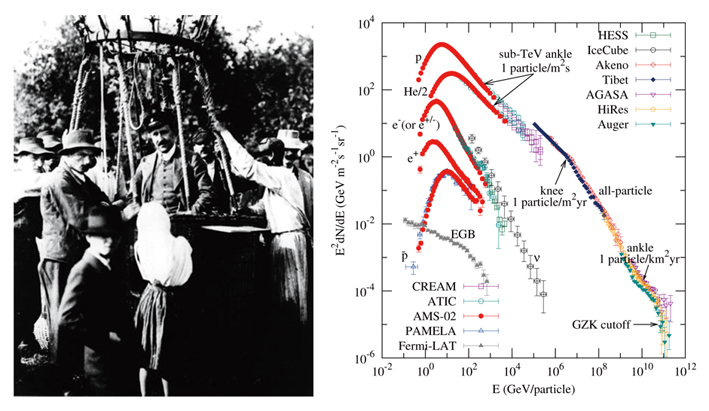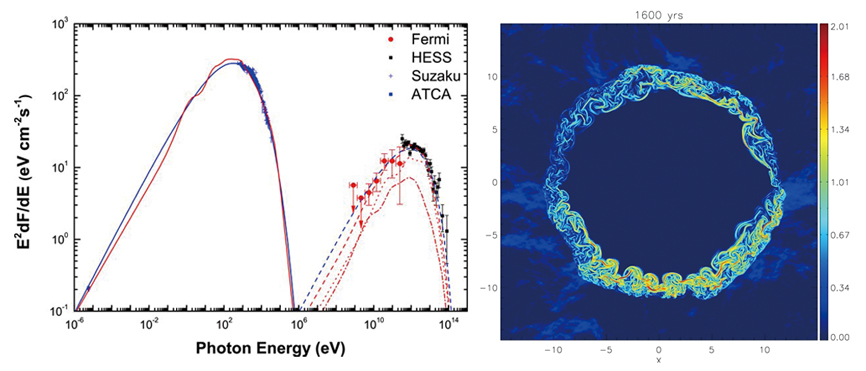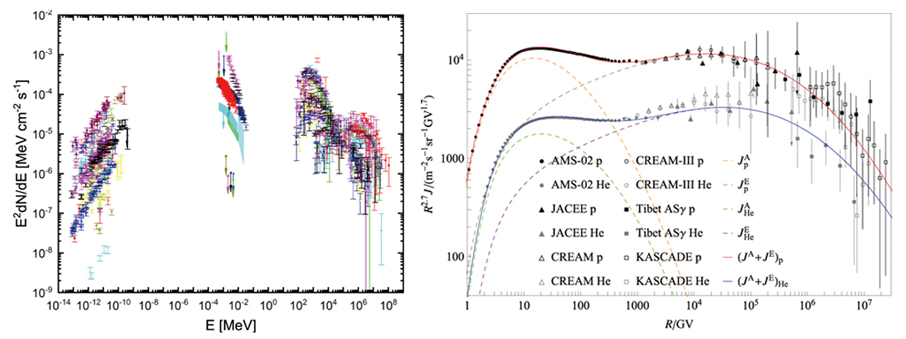LIU Siming
Purple Mountain Observatory, Chinese Academy of Sciences, Nanjing 210034, China
In the early 20th century, thanks to improved precision of ionization measurement, atmospheric ionization was widely observed and attributed to high-energy radiations generated by the decay of radioactive elements on the Earth. From 1911 to 1913, by carrying out a series of high-altitude balloon experiments, Austrian physicist Victor Franz Hess discovered high-energy radiations originated from the outer space that could also ionize the air – the cosmic rays (Hess, 1912), and this discovery earned him the Nobel Prize in Physics in 1936 (shown in Figure 1 left). In the 1930s, by analyzing the asymmetry of cosmic ray fluxes arriving from the east and the west, scientists gradually realized that these radiations are mostly composed of positively charged high-energy particles, and the flux of cosmic rays from the west is greater due to the geomagnetic field of the Earth. A series of subsequent studies revealed that 99% of the cosmic rays are nuclei, of which about 10% are alpha particles, i.e. helium nuclei, and about 1% heavier nuclei. Considering their high flux, W. Baade and F. Zwicky proposed in 1934 that cosmic rays may originate from supernova explosions (Baade & Zwicky, 1934). Given that the cosmic-ray particles are charged, their propagation in the interstellar medium is subject to deflection by the interstellar magnetic field, hence their angular distribution as observed on the Earth is nearly isotropic. Consequently, it is impossible for us to determine the sources of cosmic rays by imaging them. However, cosmic rays can interact with the background plasma to generate electromagnetic radiations ranging from radio to gamma rays. With the development of radio astronomy, X-ray astronomy, and gamma-ray astronomy, scientists not only obtained observational evidence for the supernova-remnant origin of Galactic cosmic rays, but also discovered other high-energy astrophysical sources that can also produce cosmic rays (Dubner & Giacani, 2015; Koyama, et al. 1995; Ackermann, et al. 2013; Funk, 2015).
Considering the spectral characteristics of cosmic rays (Figure 1 right), it is generally believed that cosmic rays with energies below the spectral knee at ~1015 eV (1 PeV) mainly come from the Milky Way, i.e. the so-called Galactic cosmic rays, while those with energies above the spectral ankle at ~1018 eV (1 EeV) are mostly from extra-galactic high-energy sources. Cosmic rays with energies below 109 eV (1 GeV) can hardly reach the Earth due to influence of the solar wind. Because energies of energetic particles generated by solar activity are usually below 1 GeV (Liu, 2015), most of such particles observed on the Earth are generated in the Solar System. Although many high-energy sources in the Milky Way can generate cosmic rays, supernova remnants are generally regarded as the primary source of cosmic rays from this galaxy. This is the so-called paradigm of supernova-remnant origin of Galactic cosmic rays.

Figure 1: Hess landed after a balloon experiment in 1912 (left); The flux density of cosmic rays versus energy (right; image by YUAN Qiang).
1. Establishment of the Supernova-remnant Origin of Galactic Cosmic Rays
Although in 1934 Baade and Zwicky already speculated that supernova explosions could be the main source of cosmic rays, at that times people only had some preliminary understanding of the supernova explosion process, the nature of cosmic rays, and the acceleration mechanism of high-energy charged particles. Baade and Zwicky arrived at the conclusion mainly based on their analysis of the cosmic ray flux as well as the amount of energy released from supernova explosions. People had to wait until 1948 to discover direct evidence of MeV (106 eV)-GeV high-energy electrons in the supernova remnants (Dubner & Giacani, 2015), thanks to emergence and development of the radio astronomy. These high-energy electrons, via their gyro-motion in a magnetic field, can generate radio emission. Such radio observations also revealed that the interstellar magnetic field is ubiquitous, based on which Fermi proposed his well-known Fermi acceleration mechanism of energetic particles (Fermi, 1949). According to this mechanism, high-energy charged particles could be accelerated to a very high energy via their stochastic interaction with moving magnetic clouds. Although more quantitative analyses indicated that the efficiency of this mechanism is not high enough to sustain the observed flux of cosmic rays, it is widely accepted that high-energy charged particles can be gradually accelerated by their interaction with moving magnetic fields, and this mechanism has been applied to analyze the acceleration of energetic particles in a variety of high-energy sources. The theory of diffusive shock acceleration of particles, a model derived from the Fermi’s mechanism, has become the standard acceleration model for high-energy cosmic rays (Liu, 2015).
Supernova explosions can eject part of the matter from their progenitor stars into the interstellar medium. The high-speed shock waves triggered by such ejections can accelerate charged particles. In particular, it is worth noting that some supernova explosions can also produce fast rotating pulsars, which can accelerate charged particles by dissipating their rotation energy via their magnetic field. Gamma-ray observations of the Crab Nebula show that pulsars can accelerate electrons to PeV energies (Yuan, et al. 2011). Considering that the kinetic energy carried by shock waves of supernova-remnants is generally two orders of magnitude higher than the pulsar’s rotational energy, the Galactic cosmic rays should be mainly accelerated by supernova-remnant shock waves. Nevertheless, most of the high-energy particles in supernova remnants detected by radio observations are relativistic MeV-GeV electrons. The flux of cosmic ray protons is nearly two orders of magnitude higher than that of electrons, and it is anticipated that energies of Galactic cosmic rays can reach up to the PeV level.
It was not until 1995 that scientists discovered via X-ray observations electrons being accelerated to tens of TeV (1012 eV) by shocks of supernova-remnants (Koyama, et al. 1995). In a micro-Gauss interstellar magnetic field, TeV electrons can generate X-ray emission through the synchrotron process. Considering that the energy loss rate of electrons is much higher than that of nuclei in the particle acceleration process, supernova remnant shocks should be able to accelerate protons to an even higher energy. Later, with the advance of ground-based gamma-ray observations, more than one hundred TeV gamma-ray sources were identified. A small fraction of them are high-energy galactic sources, while several dozens are associated with supernova remnants. However, these high-energy emissions can be produced not only by high-energy nuclei (including protons), but also by high-energy electrons. Direct evidence for high-energy nuclei (mainly protons) acceleration by supernova-remnant shock waves was not found until about a decade ago by gamma-ray satellites (Ackermann, et al. 2013). In typical interstellar environments, the radiation efficiency of electrons is much higher than that of nuclei; therefore, high-energy electrons generated by supernova remnant shocks can be more easily detected than ions via observations of the related emission.
Figure 2 shows the angular distribution of gamma-ray photons with energies above 1 GeV, and part of the known supernova remnants (left) and pulsars (right), as observed by the Fermi satellite. In this figure, more than half of the point sources are very active quasars, while some are active galaxies (or galactic nuclei). Their angular distribution on the sky is isotropic. Most of the gamma ray sources distributed on the galactic disk are pulsars and supernova remnants. Since pulsars can effectively accelerate electrons with a high radiation efficiency, the number of pulsars revealed by gamma-ray observations is far more than that of supernova remnants. Along the extended galactic disk, one can find the diffusive gamma-ray emission, which are mainly produced by interaction of cosmic rays with the interstellar medium in the Milky Way. Although some large-mass X-ray binaries and globular clusters have also been detected in gamma-ray band, the total energy released by them is much lower than that by supernova remnants. Consequently, it is widely believed that supernova remnants are the primary source of Galactic cosmic rays.

Figure 2: Supernova remnants (left) and pulsars (right) indicated on the all-sky maps of the Fermi gamma-ray satellite. (Credit: NASA/DOE/Fermi LAT Collaboration)
According to theories of stellar evolution, on average about three supernova explosions would occur every 100 years in the Milky Way. However, due to limited observational sensitivity, shielding by the interstellar medium, and complex environments of supernova explosions, about 2,000 pulsars have been detected so far. Some of them can be as old as hundreds of millions of years. About 300 supernova remnants have been detected by radio observations, and their ages range from one hundred years to hundreds of thousands of years. Supernova remnants of even older ages, however, are unrecognizable, as they tend to merge into the interstellar medium. Over one hundred pulsars and dozens of supernova remnants have been detected by gamma-ray observations; most of the latter are thousands of years old, and interact with molecular clouds. Dozens of supernova remnants are within 10,000 years old, and they should emit intense gamma-ray emission. Because high-energy electrons rapidly lose energy via radiation, supernova remnants that contain non-thermal X-ray emitting TeV electrons, are usually less than 10,000 years old; about a dozen such supernova remnants have been detected.
For supernova remnants aged between hundreds and thousands of years, detailed observations have been obtained in multiple bands, e.g. radio, optical, X-ray, and gamma-ray. Figure 3 shows X-ray and gamma-ray images of a supernova remnant, which is extremely bright in the tens of TeV gamma-ray range. The structure of the supernova remnant stays consistent when observed in different bands. For older supernova remnants interacting with molecular clouds, the correlation between their images in different energy bands is much worse, an outcome closely associated with the variation of mechanisms giving rise to the observed emission.

Figure 3: X-ray (left, Acero & Ballet, et al. 2009), GeV (middle; Federici & Pohl, et al. 2015) and TeV (right; Aharonian & Akhperjanian, et al. 2007) images of the supernova remnant RX J1713.7-3946.
2. Latest Developments on the Paradigm of Supernova-Remnant Origin of Galactic Cosmic Rays
Although the supernova-remnant origin of Galactic cosmic rays is supported by multi-wavelength observations of high-energy sources within the Milky Way, as well as developments of theories for particle acceleration, it is necessary to quantitatively connect the observed features of supernova remnants obtained in multi-wavelength observations with those of cosmic rays. In general, the related researches can be classified into two major aspects.
1) Propagation and interaction of cosmic rays in the interstellar medium
The interaction between cosmic rays and the interstellar medium can generate diffusive radio and gamma-ray radiations. Study in this field can be combined with observational studies of the interstellar medium to constrain the propagation characteristics of cosmic rays in the Milky Way. After more than a decade of efforts, several numerical simulation programs have been developed. Taking the observed characteristics of the interstellar medium as the background, they can quantitatively study the propagation of cosmic rays in the Milky Way and their interaction with the interstellar medium. Thereby, the propagation characteristics of cosmic rays can be studied with multi-wavelength observations. The stochastic Fermi acceleration of particles via the interaction between cosmic rays and moving magnetic clouds, as mentioned above, can also be quantitatively investigated in this approach (Fermi, 1949).
2) Acceleration of cosmic rays in high-energy source regions, i.e. generation of cosmic rays
In order to study the origin of cosmic rays with multi-wavelength observations, it is necessary to clarify the relevant emission mechanisms. The related theories for this sake are relatively well-developed, and involved emission mechanisms mainly include high-energy electrons’ synchrotron emission (which produces radio and X-ray emissions), inverse Compton scattering, bremsstrahlung emission, and the inelastic scattering of high-energy ions by background nuclei as well as the relevant secondary processes (which mainly produce gamma rays). Based on multi-wavelength observations of individual supernova remnants, combining relevant emission mechanisms and utilizing some numerical tools like magneto-hydrodynamic simulations, we can study the explosion mechanism of supernova and the corresponding particle acceleration process in detail. For the supernova remnant RX J1713.7-3946, by fitting its multi-wavelength emission spectra, we can not only obtain the spectral distribution of high-energy electrons, but also determine the average magnetic field of the remnant. These results can be combined with numerical simulations of magnetic fluids to further investigate the spatial structure of the remnant (Figure 4).

Figure 4: The multi-wavelength spectra of the supernova remnant RX J1713.7-3946 (left; Li, Liu, & Chen, 2011) and the structure of the magnetic field inside the remnant obtained by magneto-hydrodynamic simulations (right; Yang & Liu, 2013).
Multi-wavelength observations can be used to study not only the distribution of energetic particles in individual supernova remnants, but also that of a sample of remnants with good observational coverage to investigate the evolution of energetic particle distribution in supernova remnants. These studies are critical for clarifying the process of particle acceleration in supernova remnants and determining the contribution of these accelerated energetic particles to cosmic rays. Figure 5 (left) shows the multi-wavelength spectra of a sample of 35 supernova remnants with both radio and gamma-ray flux density measurements. Although the supernova remnants’ radio spectra generally follow a power law distribution, their gamma-ray spectra bear obvious evolutionary characteristics. The gamma-ray spectra of young supernova remnants are usually harder with a break at a few TeV. Such kind of gamma-ray emission is likely produced by high-energy electrons via the inverse Compton scattering process. The spectra of old supernova remnants are generally softer, and their GeV radiations are several orders of magnitude higher than their TeV radiations. Such remnants often interact with molecular clouds, and their gamma-ray emission is dominated by inelastic scattering of high-energy nuclei.

Figure 5: Multi-wavelength spectra of 35 supernova remnants with radio and gamma-ray observations (Zeng, Xin, & Liu, 2019) and a fit to anomalous spectral feature of the Galactic cosmic rays (Zhang, Liu, & Yuan, 2017).
These spectral characteristics indicate that the low flux TeV cosmic rays are mainly accelerated in young remnants, while those dominant GeV cosmic rays are mainly accelerated in older remnants. This scenario can also explain the recently observed fine structures of cosmic ray spectra (Figure 5 right) (Zhang, Liu & Yuan, 2017). Considering that young supernova remnants are distributed more unevenly in the Milky Way, the high-energy portion of the Galactic cosmic rays can be attributed not only to young supernova remnants, but also to particle acceleration in their early stages of evolution of nearby supernova remnants. This model may also explain the weak anisotropy of Galactic cosmic ray fluxes (Figure 6) (Kachelrieb, Neronov & Semikoz, 2018). The two-stage division of particle acceleration by shocks in supernova remnants may also be closely related to whether supernova remnant shocks are interacting with high-density molecular clouds or not.

Figure 6: The anisotropy in the flux of TeV cosmic rays (Ahlers & Mertsch, 2017) and the energy dependence of the phase and amplitude of the anisotropic dipole component (Amenomori & Ayabe, et al. 2006).
Conclusion and Outlook
Since the discovery of cosmic rays, more than 100 years have passed. Early observations of them have led to advances in particle physics. Although scientists proposed that supernova explosions might be the main source of cosmic rays as early as 80 years ago, the origin of cosmic rays remains a challenging issue in high-energy astrophysics for deflection from the direction of their sources of origin by interstellar magnetic fields. With advances in radio, optical, X-ray, and gamma-ray astronomy, more and more observational evidence has been found to support the scenario that they could be originated from supernova remnants in the Milky Way. It is imperative to relate observational characteristics of supernova remnants to those of cosmic rays to clarify the relevant acceleration and propagation processes of the latter.
As revealed by detailed analyses of the supernova-remnant origin of Galactic cosmic rays, this scenario consists of two major parts, addressing two major issues, i.e. 1) whether or not supernova remnant shocks can provide enough energy to sustain the energy flux of Galactic cosmic rays; 2) whether or not supernova remnant shocks can accelerate energetic particles to PeV energies. Studies of supernova explosions and related observations have shown that, on average, supernova remnant shocks can carry a bulk kinetic energy of 1×1051 erg; even if only 10% of this energy is converted into GeV cosmic rays, the flux of Galactic cosmic rays can be sustained. Moreover, as suggested by the observation that the radio spectra of supernova remnants become harder with the aging of remnants, the total efficiency of cosmic-ray acceleration is higher in older remnants, and the overall particle acceleration efficiency of supernova remnants can exceed 10% (Zhang & Liu, 2018).
Regarding the second question, although it is commonly believed that PeV cosmic rays should be accelerated in young remnants, no high-energy gamma-ray emission generated by these high-energy cosmic rays has been detected so far. The cosmic ray observatory located in Yangbajing, Tibet Autonomous Region of China, is one of the very few cosmic ray observatories in the world, and its observations have contributed a lot to the study of cosmic rays. The Large High Altitude Air Shower Observatory (LHAASO, Figure 7), which is designed and built based on experimental experience gained in observations at the Yangbajing observatory, will provide high-sensitivity gamma-ray observations at energies ranging from tens of to hundreds of TeV, and these observations are promising to clarify whether PeV cosmic rays can be generated by supernova remnants. Moreover, the high-precision measurements of the TeV cosmic ray spectrum by the DArk Matter Particle Explorer (DAMPE), also known as Wukong satellite, will also benefit the development of the theory of supernova-remnant origin of Galactic cosmic rays.

Figure 7: The Large High Altitude Air Shower Observatory (LHAASO) composed of a variety of detectors distributed over a range of one square kilometre. (Credit: IHEP)
It is particularly worth mentioning that quantitative description of the characteristics of electron cosmic rays is also important for improving the theory of supernova-remnant origin of Galactic cosmic rays. This is because many emission characteristics of supernova remnants are determined by high-energy electrons. The Fermi mechanism of cosmic-ray acceleration suggests that the acceleration efficiency of relativistic particles depends solely on the rigidity of these particles, and hence observations of high-energy electrons can be used to analyze the spectral characteristics of the corresponding nuclei. In the field of electron cosmic ray observations, both LHAASO and DAMPE are expected to produce ground-breaking results.
From theoretical point of view, uncertainties still exist concerning processes of the particle acceleration. Here, the difficulty mainly comes from complicated interactions between energetic particles and the background plasma upstream of shock waves, especially when the acceleration efficiency is high. Fortunately, with improved qualities of multi-wavelength observation data, it is possible for us to directly constrain the diffusion coefficient of energetic particles in the upstream of shock waves, as well as their escape from there. Therefore, in the near future, we can anticipate a further refinement of the theory on the supernova-remnant origin of Galactic cosmic rays.
(Translated by ZHANG Ling)
References
Hess VF. (1912) über beobachtungen der durchdringenden Strahlung bei sieben Freiballonfahren. Phys. Z., 13: 1084. https://en.wikipedia. org/wiki/Cosmic_ray.
Baade W, Zwicky F. (1934) Cosmic rays from super-novae. Astronomy, 20: 259.
Fermi E. (1949) On the Origin of the Cosmic Radiation. Physical Review, 75: 1169.
Koyama K, et al. (1995) Evidence for shock acceleration of high-energy electrons in the supernova remnant SN1006. Nature, 378: 255.
Yuan Q, et al. (2011) A statistical model for the γ-ray variability of the crab nebula, ApJ, 730: L15.
Ackermann M, et al. (2013) Detection of characteristic Pion-decay signature in supernova remnants. Science, 339: 807.
Dubner G, Giacani E. (2015) Radio emission from supernova remnants. Astron Astrophysics Rev, 23: 3.
Funk S. (2015) Space- and ground-based Gamma-ray astrophysics. Annual Reviews of Nuclear and Particle Science, 65: 245.
Siming Liu. (2015) Acceleration of charged energetic particles in the universe. Scienitia Sinica Physica, Mechanica & Astronomica. 45(11): 119509.
Zhang YR, Liu SM, Yuan Q. (2017) Anomalous distributions of primary cosmic rays as evidence for time-dependent particle acceleration in supernova remnants. ApJ, 844: L3.
Kachelrieb M, Neronov A, Semikoz DV. (2018) Cosmic ray signatures of a 2–3 Myr old local supernova. Physical Review D, 97:063011.
Zhang YR, Liu SM. (2019) Global constraints on diffusive particle acceleration by strong non-relativistic shocks. MNRAS, doi:10.1093/mnras/sty3136.

